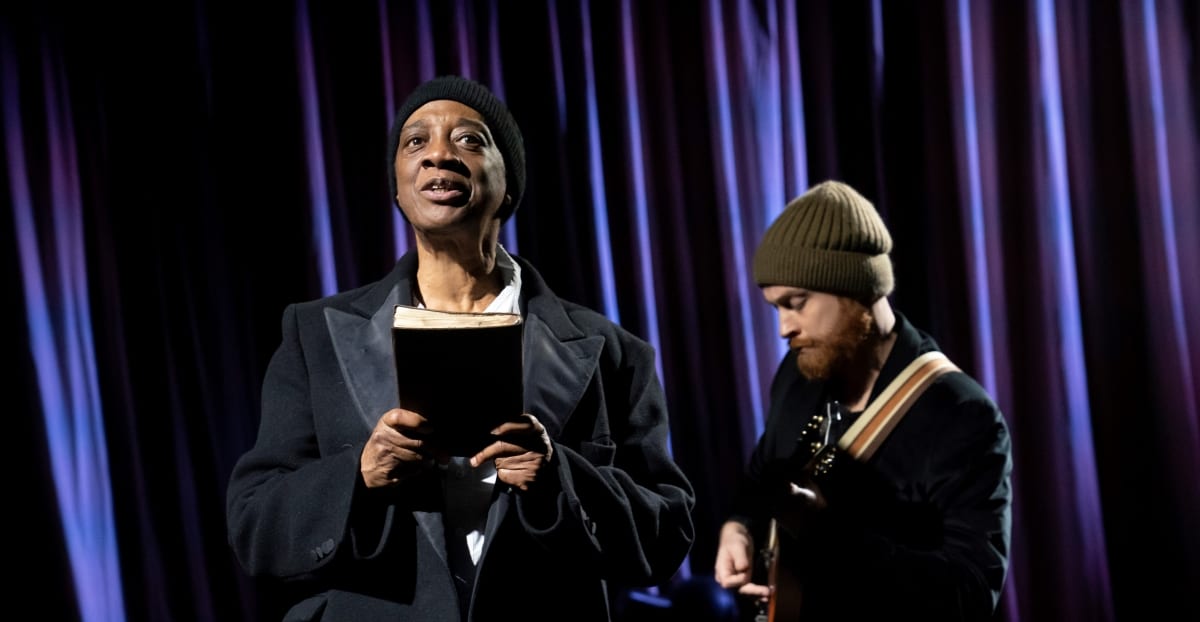Classic Stage has frankly (no pun intended) furnished its auditorium exactly how I’d expect “Frankenstein” to look: metallic and Gothic, with sparse chairs and rusty buckets surrounding a large wrought-iron operating table. And upstage sit three instruments.
Their similarly vintage look blends with the scene, yes, but their mere presence sticks out. I don’t readily imagine Mary Shelley’s story about a scientist and his increasingly-unhinged creation as “musical” — the unrelated “Young Frankenstein” notwithstanding — but Tristan Bernays has made music the crux of storytelling in his adaptation. The very first moment when the chorus (Rob Morrison) steps out to tune the instruments is followed by a haunting note that sounds like a coyote howl, signaling the eerie tale ahead. Make no mistake, “Frankenstein” is technically a play. But where words fail, a guitar speaks, and what it has to say tends to be more fascinating than the dialogue.
This is perhaps due to the fact that it’s admittedly been years since I’ve read the original novel. If you, however, know it well, you might find Bernays’ adaptation simple to navigate: the company is pared down to Stephanie Berry as the Creature and Morrison as everyone else. Berry is also billed as Victor Frankenstein, but both actors assume the role in different scenes, making it difficult to discern who’s speaking if you’re not intimately familiar with the source material.
Berry’s Creature is the persona worth noting, anyway. Her physicality is superb. When she first awakens, you’d think her body is a weighty anchor she’d truly never inhabited before that moment. Soon enough, she’s dancing to a lilting guitar tune — awkwardly, of course, but in a manner evocative of a fun-loving toddler. Equal credit for these moments is due to movement director Dyane Harvey-Salaam, who also nails the expression of grim emotional subtext through body language. An early scene shows Morrison plucking notes on the guitar and the not-yet-eloquent Creature singing (er, moaning) each note back to him on pitch. A budding friendship seems to crescendo — and suddenly, the chorus recoils as the Creature steps one foot too close to him. What was once relaxed body language and tender music becomes sharp and fearful on a dime.
Moments like these, emphasized by the casting of the bride-seeking Creature against gender, allow “Frankenstein” to be viewed as a conceit for homophobia. Others reject the Creature’s initial, innocent attempts at connection because they are horrified by the “different” way he’s made. And for all its communicative power, music is not the panacea. The Creature still becomes monstrous and murderous, and even the guitar is briefly held like a gun.
Such instrument-driven moments have a subtlety that Timothy Douglas’ direction lacks. Morrison and Berry both deliver most of their lines as though trying hard to dramatically perform. I’m willing to qualify that it’s because the Creature learned to speak from erudite books, and Morrison’s characters may be representative of the Creature’s emotionally-overcharged perspective. But combined with the equally conspicuous, primary-colored lighting (red for moments of anger and violence, yellow for morning and blue for night), it makes for a production that leaves little to be intuited.
Still, “Frankenstein” maintains the novel’s complex moral and emotional core. The actors’ and playwright’s joint investment in encapsulating longing, despair and loneliness — through music, through movement, through first words and verbose monologues — makes it riveting to watch. “Frankenstein” has heart, and not just the one repurposed to make the Creature come alive.

